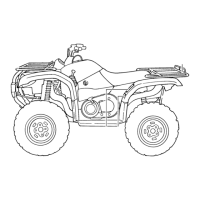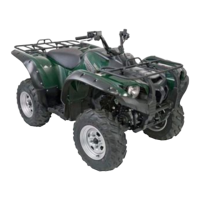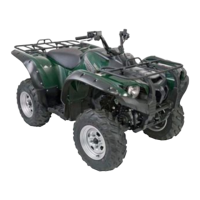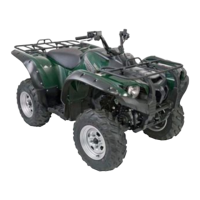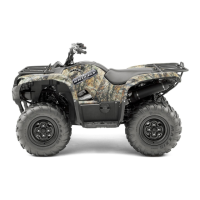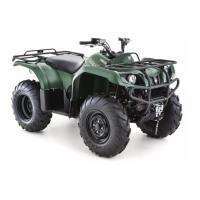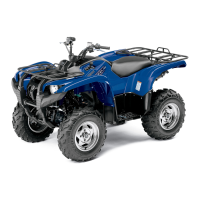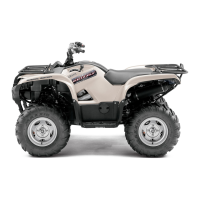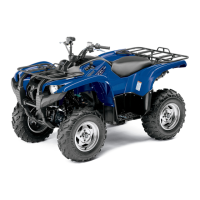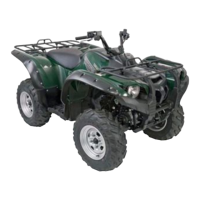
Do you have a question about the Yamaha GRIZZLY 660 YFM66FAV and is the answer not in the manual?
| Brand | Yamaha |
|---|---|
| Model | GRIZZLY 660 YFM66FAV |
| Category | Offroad Vehicle |
| Language | English |
Provides general riding instructions and emphasizes familiarization with controls for safe operation.
Explains the key identification number stamped on the key for ordering new keys.
Details the vehicle identification number stamped into the frame, including the year of manufacture.
Explains the model label and the information needed for ordering spare parts.
Stresses that ATVs are not toys and highlights risks of injury or death from improper operation.
Warns against operation by children under 16, especially with larger engines, due to severe injury risk.
Recommends wearing approved helmet, eye protection, gloves, boots, and protective clothing for safety.
Warns that alcohol or drugs impair operator performance, increasing accident risk.
Stresses the importance of knowing the terrain and being cautious on unfamiliar or rough surfaces.
Details techniques for climbing hills safely, including weight transfer and avoiding steep/slippery slopes.
Provides instructions for safe downhill riding, emphasizing weight shift and braking.
Provides advice on controlling sliding and skidding, emphasizing caution on slippery surfaces.
Offers guidance for specific riding situations like non-turning, tipping, or sliding.
Explains the key identification number stamped on the key for ordering new keys.
Details the vehicle identification number stamped into the frame, including the year of manufacture.
Explains the model label and the information needed for ordering spare parts.
Explains the ON and OFF positions of the main switch and their functions.
Describes various indicator lights on the dashboard, including differential lock, range, and temperature warnings.
Details the function of handlebar switches like lights, start, engine stop, horn, and override.
Explains the operation of the On-Command 4WD and differential gear lock switches for selecting drive modes.
Describes throttle lever operation and speed limiter adjustment for controlling engine speed.
Details the front brake lever, rear brake lever, and brake pedal operation and adjustment.
Explains the drive select lever operation, reverse driving, and recoil starter usage.
Describes the fuel cock positions and the starter (choke) operation for cold engines.
Details checks for brake operation, fluid level, and leakage, including free play and pedal height.
Instructs to check fuel level and fill if necessary, with specific notes for Europe.
Details checking engine oil level and cautions regarding additives and foreign material.
Lists approved tires and warnings about improper pressure or type, advising correct settings.
Explains the procedure for measuring tire pressure using the included gauge and recommended specifications.
Provides a comprehensive schedule for initial and periodic maintenance tasks and lubrication based on time or mileage.
Explains the procedures for removing and reinstalling various panels to access components for maintenance.
Details how to check engine oil level and replace the oil filter cartridge, including cautions.
Provides step-by-step instructions for changing the coolant, including warnings and cautions.
Details how to remove, inspect, and install the spark plug, including specifications and maintenance.
Explains carburetor adjustment, recommending dealer service for most adjustments and owner's role in idle speed.
States that brake fluid replacement should be done by trained Yamaha personnel, including component replacement intervals.
Introduces troubleshooting for starting problems or poor engine performance, recommending dealer service and use of genuine parts.
Provides general riding instructions and emphasizes familiarization with controls for safe operation.
Offers advice on riding with care, emphasizing training for inexperienced riders and familiarization.
Warns against operation by children under 16, especially with larger engines, due to severe injury risk.
Recommends wearing approved helmet, eye protection, gloves, boots, and protective clothing for safety.
Stresses the importance of knowing the terrain and being cautious on unfamiliar or rough surfaces.
Details techniques for climbing hills safely, including weight transfer and avoiding steep/slippery slopes.
Provides instructions for safe downhill riding, emphasizing weight shift and braking.
Provides advice on controlling sliding and skidding, emphasizing caution on slippery surfaces.
Offers guidance for specific riding situations like non-turning, tipping, or sliding.
Lists key physical dimensions of the ATV, such as length, width, height, wheelbase, and ground clearance.
Details engine type, cylinder arrangement, displacement, bore, stroke, and compression ratio.
Specifies recommended engine oil types, classifications, and quantities, with cautions regarding additives.
Details recommended fuel type, tank capacity, and reserve amount, with specific notes for Europe.
Specifies tire type (Tubeless) and sizes for front and rear wheels, along with warnings.
Provides a table for converting metric unit values to imperial unit values for various measurements.
